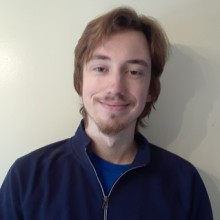Testing Things Out: An Intern’s Experiences at the Canada Aviation and Space Museum

The Task at Hand
I’ve always had a passion for all types of history, including aviation. As an Algonquin College student in the Applied Museum Studies program, the Canada Aviation and Space Museum seemed like the perfect place to complete my final-year field placement. I visited the museum many times growing up, so it felt like a logical step to do my internship there as well.
Working at the museum, I gained firsthand experience and was able to apply what I had been learning in a real-world environment. The placement focused on interpretation and exhibition development, and I worked under the supervision of the museum’s Exhibition Interpretation Officer, Erin Poulton. Over the course of the placement, I completed many projects, such as developing braille-based self-guided tours for people with visual impairments, conducting accessibility testing, creating interpretive text, archiving usage rights for images in exhibitions, and writing descriptive captions for educational videos. Working on such a variety of projects was very rewarding. I was able to participate in projects at different stages of development, each with its own unique quirks and nuances. In future, I know I’ll be able to build off the wide range of experiences I had during my placement.
Visitor Testing
Though I felt that all of my projects were compelling in their own way, one of the most memorable was conducting visitor testing. The Canada Aviation and Space Museum is starting a major update to its Jet Age section, which will now focus on the Cold War. In order for the Exhibition Interpretion Officer to learn more about visitors’ existing knowledge of the era, and what themes interest them most, I was tasked with conducting formative testing. Questions gauged levels of knowledge and interest in topics in general, as well as specific aspects, such as the threat of nuclear war, and the Canadian aircraft industry.
I conducted interviews during a two-week period, aligning with high March Break visitation. Participants were asked a series of questions related to the exhibition’s potential themes, and sorted a series of topics based on their levels interest. Answers, along with helpful observations, were recorded and compiled in a testing report to assist the core exhibition team as they make decisions about the project’s development. Over the two-week period I surveyed 87 visitors.
Observations
After completing the Cold War testing, my impression was that a strong majority of the participants were familiar with the topic, and that they had a solid interest in learning more. I quickly understood the importance of having direct contact with visitors. Since the focus of my placement was interpretation and exhibition development, I was glad to gain this first-hand experience. Being able to speak with people directly allowed me to hear different perspectives and gain a better sense of what visitors want to learn more about at the museum. Interestingly, even when visitors thought they lacked knowledge of a topic, they usually shared a general sense of enthusiasm and openness for opportunities to learn more.
A Piece of the Puzzle
As a student beginning my career in the museum field, testing was especially compelling to me as I was able to be part of the broader exhibition development process. I appreciated being able to contribute to a large-scale project and help shape this new exhibition’s content. Not only was I able to participate in the process, but I enabled visitors to play a part as well. Through performing visitor testing, I helped to ensure that visitors’ opinions influence the content that they will eventually be invited to explore. With a deeper understanding of what visitors want, museums can craft experiences that better appeal to them. I am thrilled knowing that I was able to contribute to this future exhibition by helping to shape the visitor experience.
Final Thoughts
Working as an intern at the Canada Aviation and Space Museum for four months has been a very enriching experience. Completing projects related to interpretation, such as visitor testing, will serve me well as I begin my career as a museum professional. I have always had a passion for history and museums, and look forward to sharing this with others. In the future, I hope to help influence what stories are told in exhibitions, and shape how visitors engage with these narratives.
Enjoying the Ingenium Channel? Help us improve your experience with a short survey!








![A block of photographs showing some of the people involved in the bombing of beluga whales in the estuary and gulf of the St. Lawrence River. Anon., “La chasse aux marsouins [sic]. » Le Devoir, 15 August 1929, 6.](/sites/default/files/styles/thumbnail_7/public/2024-09/Le%20Devoir%2015%20aout%201929%20page%206.jpg?h=584f1d27&itok=TppdLItg)






